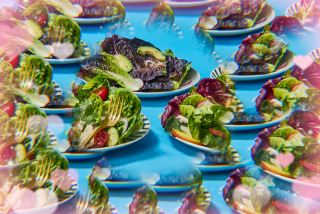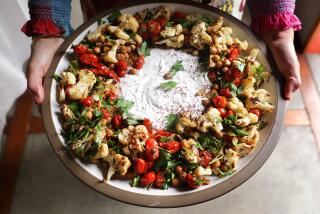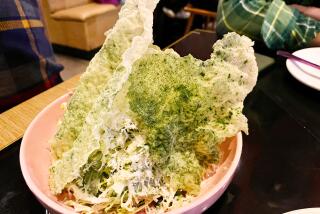Salad Dressings: The Light Side
Dear Eating Right: I’m on a diet and eat a lot of salads. Lately, I’ve noticed “lite” and “reduced-calorie” dressings in my supermarket. Are these dressings really fat-free? --MARGE
Dear Marge: Now that “fat-free” dressings have joined regular, reduced-calorie and lite dressings in the supermarket, it’s more important than ever to read labels carefully. Ignore the front of the bottle and check the ingredient list; it will tell you how much and which kind of fat is used in the product--if any is used at all.
For the record:
12:00 a.m. March 14, 1991 FOR THE RECORD
Los Angeles Times Thursday March 14, 1991 Home Edition Food Part H Page 45 Column 3 Food Desk 3 inches; 81 words Type of Material: Correction
The Low-Fat Ranch Dressing recipe in the Feb. 28 Eating Right column contained an error. The correct recipe follows.
LOW-FAT RANCH DRESSING
1/2 cup nonfat cottage cheese
1/4 cup buttermilk
1/2 teaspoon parsley flakes
1/2 teaspoon garlic powder
1/2 teaspoon onion powder
1/4 teaspoon garlic salt
1/4 teaspoon sugar
1/2 teaspoon seasoned salt
Dash seasoned pepper
Combine cheese and buttermilk in blender and blend until smooth. Add parsley, garlic and onion powders, garlic salt, sugar, seasoned salt and pepper. Blend until thoroughly mixed. Makes about 2/3 cup dressing.
Also, remember that the serving size on the label is usually just a tablespoon. Some restaurant ladles hold around three tablespoons, so you may be eating more fat than you think.
Regular salad dressing starts with a base of oil or mayonnaise to which flavors and seasonings are added. Some dressings have a mixture of both types of fat.
To make reduced-calorie dressings, manufacturers start with typical salad dressing ingredients, then add commercial thickeners such as xanthan gum, guar gum and carageenan to give the dressing its familiar thick, creamy texture. Or they dilute the fat with water or vinegar.
Some of the highest-fat dressings can have as much as 10 grams of fat per tablespoon. Ranch dressings, for instance, are based almost entirely upon fat; the ranch dressings that merit a “reduced-fat” rating usually have two to three grams of fat per tablespoon. The lowest-fat dressings contain zero or one gram of fat per tablespoon. These are often called fat-free.
In order to comply with Food and Drug Administration label requirements, dressings labeled “reduced-calorie” must contain at least one-third fewer calories than the original, but there still is no legal definition for “lite.” These foods may be lighter in flavor or color yet contain the same amount of fat and calories as regular dressings.
Here’s another reason to watch how much salad dressing you eat: Manufacturers compensate for the missing flavor of fat with salty spices, sugar and seasonings. This is especially true in the fat-free versions, which are primarily synthetic.
In an informal tasting, Take Heart Ranch from Hidden Valley Ranch looked, smelled, poured and tasted closest to the original dressing. It has just one gram of fat per tablespoon and 20 calories. But Weight Watchers’ Creamy Ranch, with 25 calories but no fat, was offensively sweet; Kraft’s Fat Free Ranch, also with just 16 calories and no fat, had a strong garlic and vinegar taste.
Remember that the dressing is meant to be an embellishment; you should still be able to taste the vegetables in a salad. If you’re drowning it in dressing you might as well eat a hamburger.
Making your own dressing at home can be a healthy alternative to commercial dressings. Stir your favorite herbs, spices and flavors into nonfat plain yogurt and eliminate mayonnaise and oil entirely. This recipe Low-fat Ranch Dressing gets its smooth texture from non-fat cottage cheese and low-fat buttermilk milk and its flavor from onion and garlic powders; you may wish to use fresh garlic and onion.
LOWFAT RANCH DRESSING
1/2 cup nonfat cottage cheese
1/4 cup nonfat milk
1/2 teaspoon parsley flakes
1/2 teaspoon garlic powder
1/2 teaspoon onion powder
1/4 teaspoon garlic salt
1/4 teaspoon sugar
1/2 teaspoon seasoned salt
Dash seasoned pepper
Combine cheese and milk in blender and blend until smooth. Add parsley, garlic and onion powders, garlic salt, sugar, seasoned salt and seasoned pepper. Blend until thoroughly mixed. Makes about 2/3 cup dressing.
Calories Fat Cholesterol Sodium One Tablespoon Regular Dressing Ranch 80 8 10 140 Blue Cheese 75 8 3 164 French 85 9 0 188 Thousand Island 60 6 4 112 Italian 80 9 0 162 One Tablespoon Hidden Val- ley “Take Heart” Ranch 20 1 0 140 Blue Cheese 12 0 0 140 French 20 0 0 115 Thousand Island 20 0 0 140 Italian 16 0 0 140 One Tablespoon Kraft “Free” Ranch 16 0 0 150 Blue Cheese 16 0 0 120 French 20 0 0 120 Thousand Island 20 0 0 135 Italian 6 0 0 210 One Tablespoon Weight Watchers Ranch 25 0 NA 100 French 10 0 0 170 Thousand Island 50 5 5 80 Creamy Italian 50 5 5 80 One Tablespoon Wishbone “Lite” Ranch 45 4 5 150 Blue Cheese 40 4 0 200 French 30 2 0 65 Thousand Island 40 3 65 110 Italian 6 0 0 210
Source: Product labels
Only questions of general interest will be printed. Eating Right cannot respond to inquiries regarding therapy for a specific ailment, nor is this column designed to replace medical advice. Send diet and health questions to Eating Right, Food Section, The Times, Times Mirror Square, Los Angeles 90053.
More to Read
Eat your way across L.A.
Get our weekly Tasting Notes newsletter for reviews, news and more.
You may occasionally receive promotional content from the Los Angeles Times.










